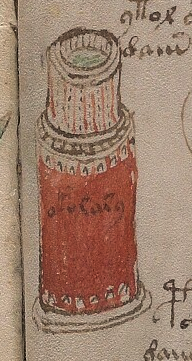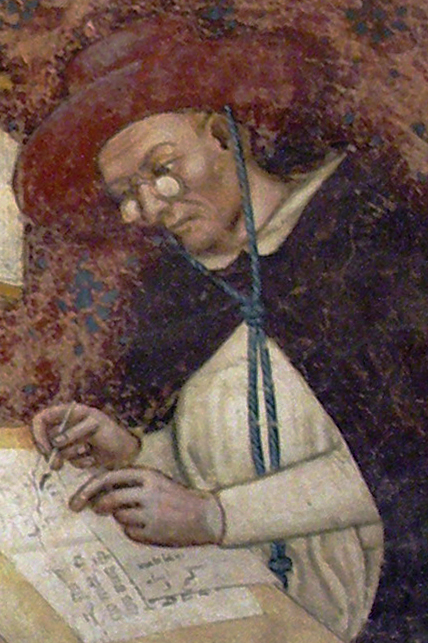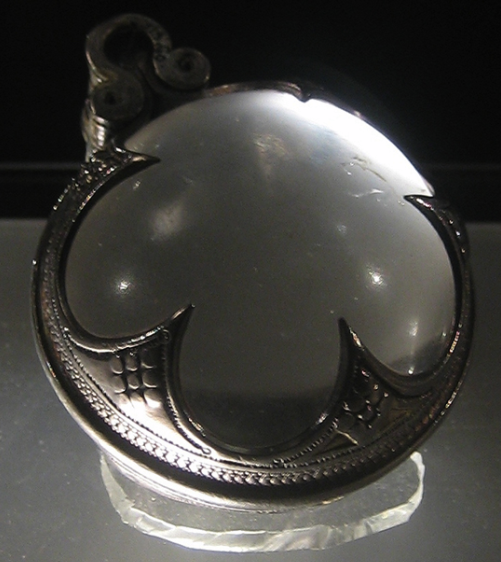buy Lyrica online In 1267, Roger Bacon sent his Opus Maius and a number of related treatises to Pope Clement IV. The works comprised a brave and impassioned plea for scientific inquiry into all aspects of life (including the occult arts and arts practiced by folk outside of scholarly circles). Friar Bacon hoped that the support of the pope could raise the Catholic faith above its traditional limitations, but Clement IV died in 1268 and may not have read Bacon’s writings. In 1277, Bacon was condemned and subsequently imprisoned for his outspoken and unconventional views, and lived only a short time after being released in 1292.
 Bacon loved science and one of the subjects dear to his heart was optics. This may be of interest to researchers studying containers in the Voynich Manuscript because some have said that c. 1404 to c. 1438 is too early for any of the containers to be reading tubes or telescopes, but this statement by John Henry Bridges in 1900 suggests the technology may have been available long before the VMS:
Bacon loved science and one of the subjects dear to his heart was optics. This may be of interest to researchers studying containers in the Voynich Manuscript because some have said that c. 1404 to c. 1438 is too early for any of the containers to be reading tubes or telescopes, but this statement by John Henry Bridges in 1900 suggests the technology may have been available long before the VMS:
Of the magnifying powers of convex lenses Bacon had a clear comprehension. He imagined, and was within measurable distance of effecting, the combination of lenses which was to bring far things near, but which was not to be realized till the time of Galileo…. in his Optics Bacon shows that he was acquainted with the properties of parabolic concave mirrors, and of their power of causing parallel rays to converge after reflection to a focus. in this respect he was in advance of his principal teachers in Optic, Euclid, Ptolemy, and Alhazen.
Bacon was familiar with parabolic concave mirrors, had a specific interest in lenses (and may have had some in his possession), and was far ahead of his time in believing that radiant energy could pass through space and air independently of the eye (in contrast to those who asserted that sight was based on the eye producing light rays).
Commentators say that Bacon derived much of his knowledge from Alhazen’s Thesaurus Opticae, but understood it from a fresh perspective in which he questioned traditional assumptions and pursued the ideas as practical embodiments.
Bacon may have been very close to inventing telescopes and microscopes before his tragic incarceration in the late 1270s, and others must have been inspired by him or had similar ideas, because wearable eyeglasses appear to have been in use by 1270, as attested in German Minnesänger ballads, mentioned by C. Barck in 1907 and located by Villiers and Pike in the German Handbook of Inventions by Busch (1795):
Brille besteht aus zwei geschliffenen durch eine Einfassung mit einander verbundenen Gläsern, durch welche die Gegenstände den Augen deutlicher erscheinen. [Eyeglasses are made from two ground/polished glasses, which are connected to one another through a mount/rim, through which the eyes will more clearly see objects.]
The Busch passage illustrated in German script by Villiers and Pike states that Roger Bacon believed that eyeglasses were known in Germany by 1270, quotes the above passages, and writes that they say expressly that old people used them [eyeglasses] to read.
The invention of eyeglasses has sometimes been credited to Salvino d’Armati, in 1284, but in the absence of a supposed epitaph on his tombstone, no evidence supports this claim, and the Minnesänger reference predates it by 14 years.
Friar Alessandro della Spina is said to have created eyeglasses late in the 13th century based on ideas obtained from an unnamed craftsman, possibly by a Pisa artisan. In the archives of 1313, the apparent year of Alessandro’s death, is written:
Brother Alessandro della Spina, a modest and good man, learned to make all industrial products of which he saw or heard. Spectacles, which were made first by some one else, who did not want to communicate anything about them, were then made by him, and were distributed with a cheerful and benevolent heart. [C. Barck, 1907]
Bacon mentions reading lenses (ground-crystal lenses placed directly on parchment to magnify the area beneath it). These lenses were more convenient than using a glass globe of water as a magnifier, an idea that had been around since the time of Seneca (c. 30 CE).
Reading tubes (short sighting tubes with lenses added) probably also preceded wearable glasses. It was a logical evolution, as lensless sighting tubes existed in early Greco-Roman times.
Early lenses were not always vision aids—some were decorative, and some were used to concentrate sunlight to illuminate a dark corner or start a flame, but their magnification abilities did not go unnoticed, and lens development was not confined to the south—crystal lenses were made in Scandinavia, as well. Lathe-turned lenses of a quality and shape that was remarkable for the early medieval period (and which were close to optimum for magnification) have been found in Viking graves on the island of Gottland (Sweden).Summary

Fresco painting of Dominican Cardinal Hughes de St. Cher wearing glasses. [Risorto Celebrano, on Wikipedia].
Vincent Ilardi, in his book on historic eyeglasses and telescopes (2007), describes documents in which the firm of Francesco di Marco Datino of Prato and Florence purchased eyeglasses from Venice, in July 1400. He also references a pair of spectacles that was donated by Francesco Datini to Franciscan friar Bonifazio Ruspi (originally of Florence but, at that time, in Corsica).
Documents relating to purchases by the Sforzas and duke of Milan confirm the use of spectacles in Florence which, by the mid-15th century were available in a variety of styles and magnifications.
Thus, we can see that reading lenses and spectacles (and probably also reading tubes) preceded the VMS by at least 115 years and their possible inclusion in the manuscript is not inconsistent with early 15th-century technology.
J.K. Petersen
Copyright © 2018, All Rights Reserved


Historians doubt that Bacon was ‘incarcerated’ – but the evidence for and against can’t be summarised fairly in a blog-comment.
I think that considering the amount of time and research that Santacoloma expended in exploring the notion of lenses, it would be appropriate to mention his name too.
As for myself, when I looked into it – in connection with a few micrographic glyphs on f.9v (which, by the way, one of the four most respected specialists in the field confirmed as apparently an effort by a person untrained in Hebrew to write Hebrew in that micrographic style which was the speciality of the Karaites and later of the western Jews – I found that there appears to have been little need for more than the sort of ‘reading glass’ known from c.1000 AD even in the west. They are attested a great deal earlier in Mesopotamia and in India, btw.
Here’s one of the illustrations I used, in case it is of interest to you and your readers.
https://voynichimagery.files.wordpress.com/2016/04/a-reading-stone-lense-spectacles-dated-1000ad.jpg
btw – his name was bleached out by a certain foolish book-seller and Wilfrid actually confessed to that.
by ‘historical evidence’ I mean evidence – not the dim memory of a man in the last stages of a mentally debilitating illness, to which his close friend attests, and which reached its natural termination 18months or so later. I mean evidence.
D. O’Donovan wrote: “I think that considering the amount of time and research that Santacoloma expended in exploring the notion of lenses, it would be appropriate to mention his name too.”
What would you like me to say? SantaColoma has proposed that microscopic imagery and containers that resemble magnifying tubes in the VMS point to a later date and support his idea that the VMS is a modern fake or forgery.
I believe the opposite—that the VMS is a genuine circa early 15th-century manuscript and, as pointed out in this article, that reading tubes, reading stones, and reading bowls were available, to a limited extent, during earlier time periods and do not provide hard evidence for a later creation date.
This image is from the Bute Psalter (courtesy of the Getty Museum), c. late 1200s:
https://voynichportal.com/wp-content/uploads/2019/01/SpectaclesBute32v.png
It might be a double mirror, but it is thought by some to be a pair of spectacles (note the eyes, the hand gesture and the nearby text “illuminatio”).
If you doubt these devices existed in the 13th century, consider that an inventory of the belongings of Guy de Dampierre, count of Flanders (c. 1226—1305), cited by the Getty Museum in 1995 from http://eecoswitch.com/our-companies Documents et extraits divers concernant l’histoire de l’art dans la Flandre, l’Artois et le Hainaut avant le XVé siècle, reports spectacles for reading, bordered with brass [brass rims]—”i espectacle pour lire bordé de laiton” (C. Dehaisnes).
JKP – Oh no, I wasn’t suggesting that by mentioning the research already done on a given topic is
like a product-endorsement for the authors’ ‘theories’.
Given the necessary information, though, your readers will be able to see what has already been looked into by people who really have researched a topic – regardless of their overall theories.
This has benefits for them – avoiding endless re-invention of wheels. And it has benefits for you; it shows you’re not writing in a mistaken belief you are the first to treat a topic; it also proves you’re not a cut-and-paster, and most importantly, it lets your readers see where your work fits into the evolving history of this manuscript’s investigation.
My word, if I thought people imagined that by mentioning the views of Wilfrid Voynich, William Friedman, Raphael Prinke, Nick Pelling, or Santacoloma … or any other researcher since 1912 – would be supposed endorsement of their ‘theories’, I’d have to pretend the only people who existed in the history of this study were me and such persons I happen to agree with.
Diane, I don’t care if I am the first to “treat a topic”. I have my own way of looking at things and my conclusions are frequently different from those of others.
I enjoy the thrill of the hunt, the joy of discovery. Most of the “prior research” in Voynich studies is useless anyway. On the occasions when I have looked at prior research, I have been disappointed, usually disagree, or find it to be speculation (a simple hunch with no actual evidence or legwork to back it up).
I don’t care if someone has been down the same road, I usually end up exploring it in a different way and coming to a different conclusion.
I’ve seen some good posts by Pelling, Marco Ponzi, K. Gheuens, and VViews, and I think R. Zandbergen is doing a good job of compiling a reference site, but most of the other historical information is inadequate or simply wrong. Even Mary D’Imperio’s paper (which I finally read a couple of months ago) is inadequate. The info on the state machine is a step in the right direction, but she never followed through with other statistical attacks and never fully described the ramifications of certain patterns within the VMS. In other words, even though it’s one of the more sensible articles, it’s barely more than an introduction to a concept I already knew.